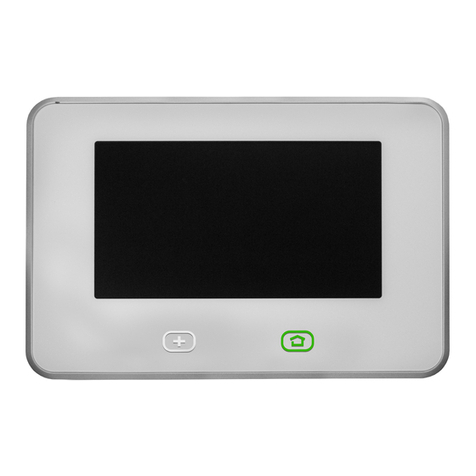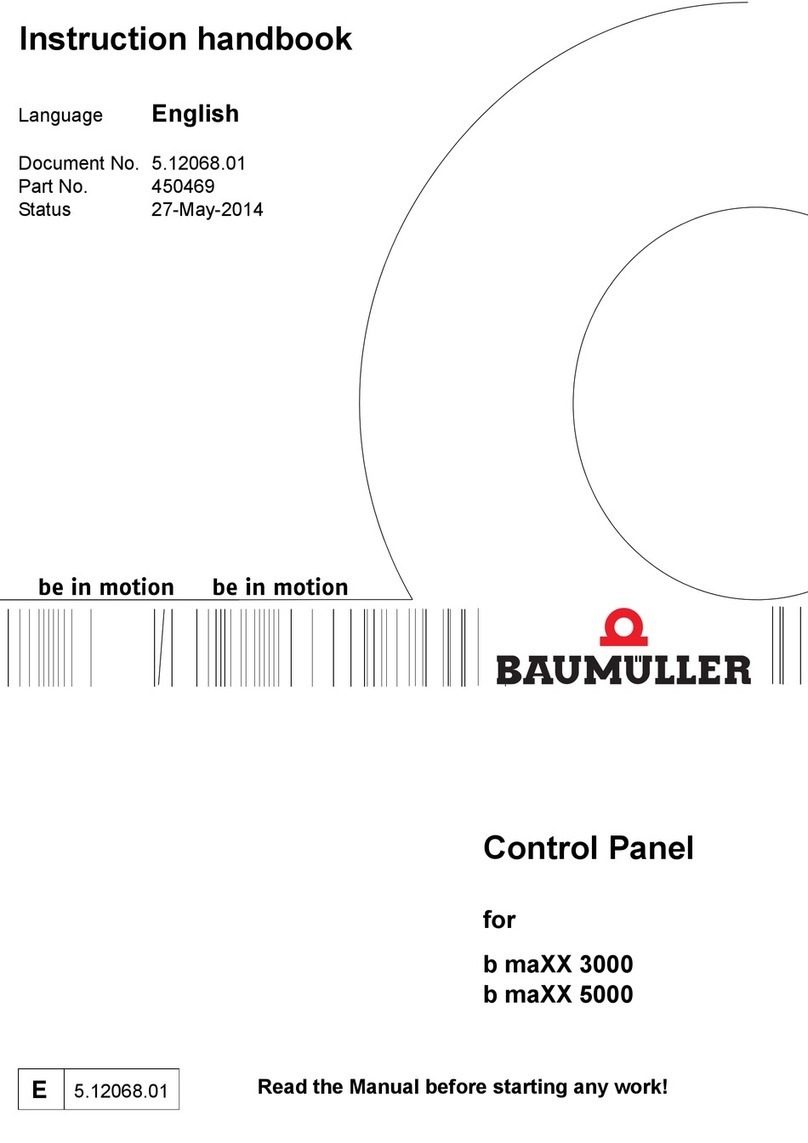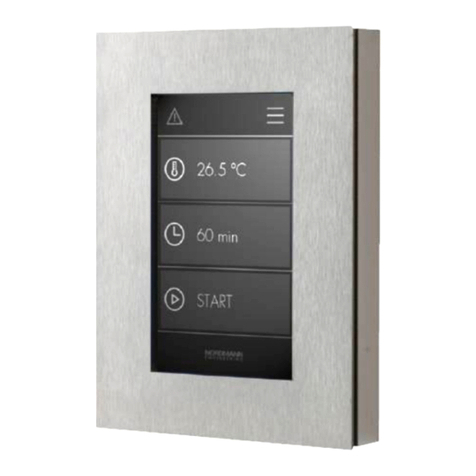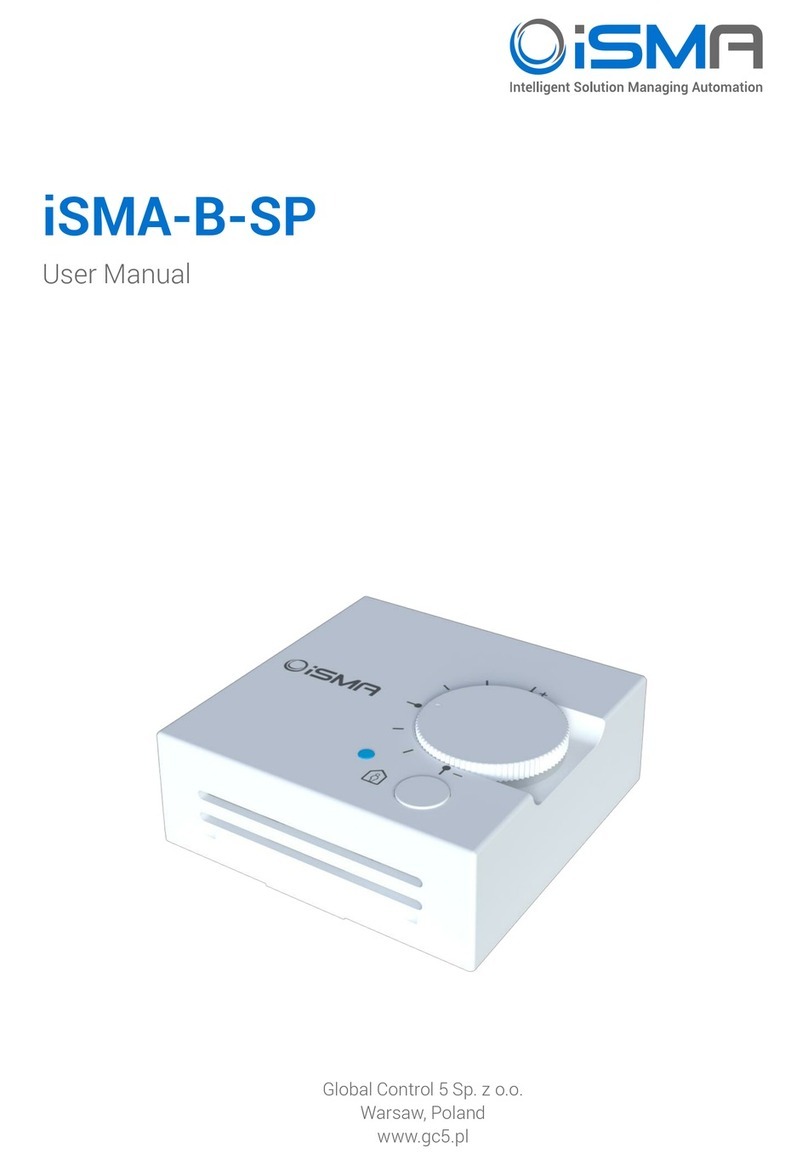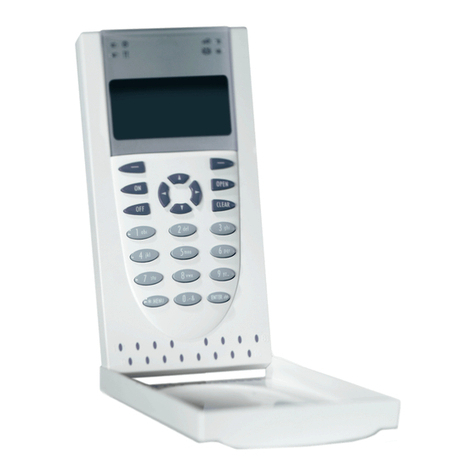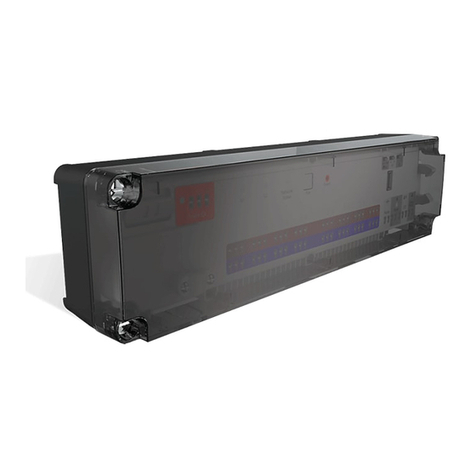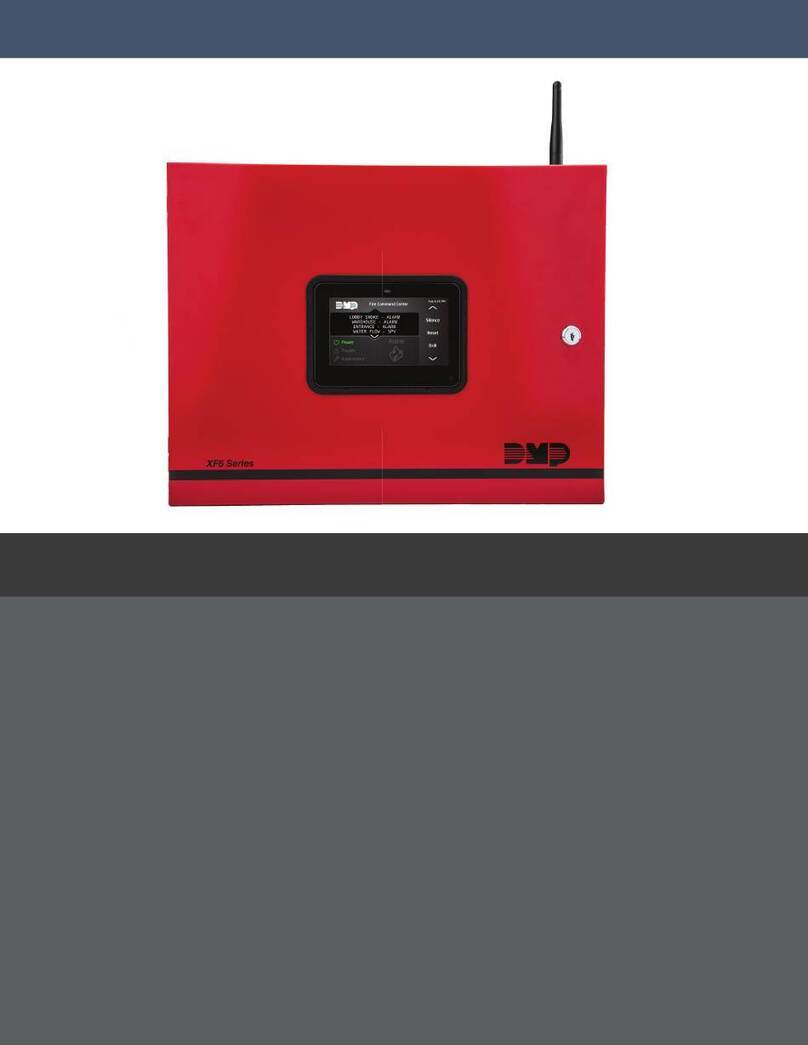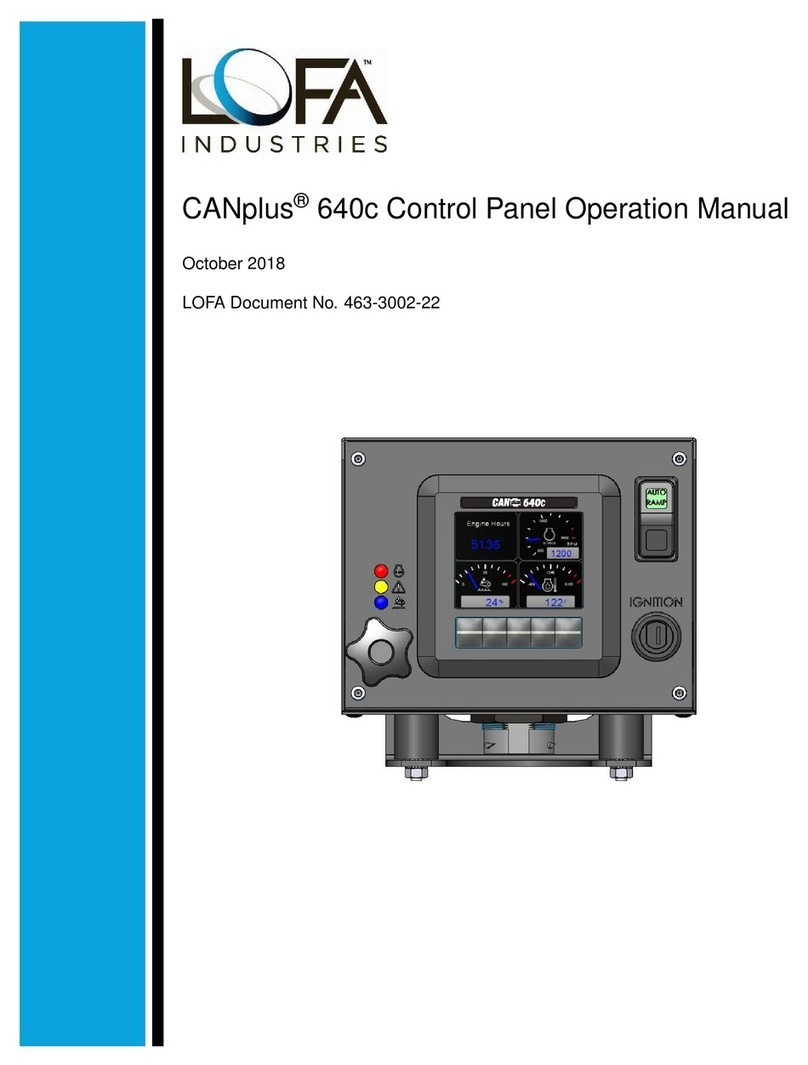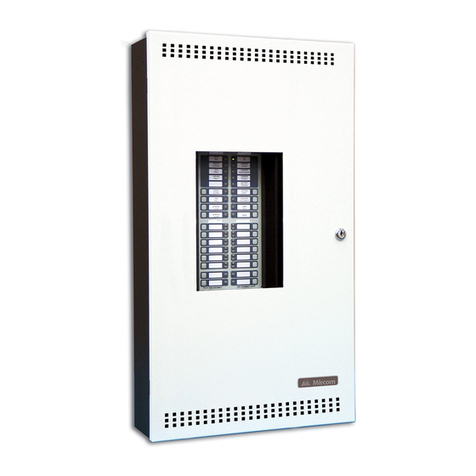Tate Premier SX User manual

.
35(0,(56;
),5($/$50
&21752/3$1(/
86(50$18$/
0$,17(1$1&(*8,'(
/2*%22.

PREMIER SX USER MANUAL, MAINTENANCE GUIDE & LOG BOOK
Approved Document No: GLT.MAN-102T PAGE 2
Issue: 1.1 Authorised: GH Date: 06/11/02
CONTENTS
1. Safety …………………………………………………………………………………… 3
Important information regarding the safe use of this Fire Alarm Panel
2. Fire Alarm Systems …………………………………………………………………… 3
How fire alarm systems operate and a general overview of the key features
3. User Responsibilities ………………………………………………………………… 4
General guidelines on what the User is expected to do, including daily, weekly,
quarterly & annual checks
4. Panel Layout/Accessing the Controls …………………………………………….. 5
A summary of the controls and indicators available on the Fire Alarm Panel
4.1 GENERAL CONTROLS
4.2 ACCESSED CONTROLS
4.3 WHAT THE INDICATORS MEAN
4.4 TESTING THE INDICATOR LIGHTS
5. Fire Conditions ………………………………………………………………………… 7
5.1 HOW AN ALARM IS INDICATED
5.2 SILENCING THE ALARM SOUNDERS
5.3 NEW ZONE IN ALARM
5.4 MANUALLY ACTIVATING THE ALARM SOUNDERS
5.5 RESETTING THE PANEL
6. Fault Conditions ………………………………………………………………………. 8
6.1 DIFFERENT TYPES OF FAULT
6.2 IN THE EVENT OF A FAULT CONDITION
7. Disablements …………………………………..……………………………………… 10
7.1 REASONS FOR DISABLING CERTAIN PARTS OF A FIRE ALARM SYSTEM
7.2 TO DISABLE A ZONE AND/OR EXTERNAL SOUNDER
7.3 TO ENABLE A ZONE AND/OR EXTERNAL SOUNDER
8. Notes on Delays ………………………………………………………………………. 11
8.1 WHAT IS A DELAY
8.2 DELAY OPTIONS
8.3 DELAY INDICATION
8.4 WHAT HAPPENS IF THERE IS A FIRE ALARM CONDITION ON A DELAYED
PANEL
8.5 HOW TO OVERRIDE A DELAY IN THE EVENT OF A TRUE ALARM CONDITION
8.6 HOW TO RESET THE SYSTEM IN THE EVENT OF A FALSE ALARM
8.7 HOW TO TURN OFF THE SOUNDER DELAY
9. System Set-up Data Chart …………………………………………………………... 12
Details of how the System has been set-up
10. Log Book ……………………………………………………………………………….. 13
A place for you to record details of events such as fires, false alarms, call
outs, etc.
11 Commissioning the system ………………………………………………………… 15
11.1 Installation and Commissioning Certificate ……………………………………… 15

PREMIER SX USER MANUAL, MAINTENANCE GUIDE & LOG BOOK
Approved Document No: GLT.MAN-102T PAGE 3
Issue: 1.1 Authorised: GH Date: 06/11/02
1. SAFETY
This Fire Alarm Panel is safe to operate provided it has been installed in compliance with the Manufacturers
instructions and used in accordance with the Manual.
Do not open the Fire Alarm Panel enclosure . There is no need to open the enclosure except to carry out
commissioning, maintenance and remedial work. This work must only be carried out by competent service
personnel who are fully conversant with the contents of the separate engineering manual for this product.
If the enclosure is damaged in any way, expert advice should be sought regarding its repair.
Regular Servicing of the Fire Alarm System is highly recommended, preferably on a continuous maintenance
contract and by a competent organisation. A fully-itemised report of the installation should be obtained at least
annually.
&(
&( (XURSHDQ 8QLR
(XURSHDQ 8QLRQ
Q 'LUHFWLYHV &RQIRUPDQFH
'LUHFWLYHV &RQIRUPDQFH 6WDWHPHQW
6WDWHPHQW
This product has been manufactured in conformance with the requirements of all
applicable EU Council Directives. The Declaration of Conformance for this
product is located at the following Address: GLT Exports Ltd, 72-78 Morfa Road,
Hafod, Swansea, SA1 2EN, United Kingdom
2. FIRE ALARM SYSTEMS –AN OVERVIEW
The primary purpose of a Fire Alarm System is to provide an early warning of a fire so that people and animals
can be evacuated and action taken to stop the fire as soon as possible – all according to a predetermined plan.
Alarms may be raised automatically by Smoke or Heat Detectors, or manually be a person operating a Manual
Call Point.
To ensure an Alarm is dealt with in an orderly manner, it is important to know where the alarm is coming from.
To do this, Fire Alarm systems are usually split into Zones, each covering a different area of a building.
When an Alarm has been raised, the Fire Alarm Panel responds by indicating the Zone in which the Alarm has
occurred and activating all relevant Sounders, Bells and other Alarm Outputs to provide a warning of the fire.
• A Remote Output: normally used to transmit an Alarm condition to an off-site permanently manned
monitoring centre. On receipt of the Alarm signal, the Centre notifies the local Fire Brigade of the Fire
Condition.
• An Auxiliary Output: normally used to trigger local fire fighting equipment such as magnetic door
release systems (to automatically close fire doors), plant shutdown systems (to automatically switch off
potentially hazardous machines), sprinkler systems, etc.
Fault Monitoring
For obvious reasons the reliability of the Fire Alarm System is paramount. To this end, the fire alarm panel
continuously monitors all connections between Detectors, Manual Call Points and Sounders and checks its own
power supply and back-up batteries for faults.
If a fault is detected anywhere on the System, the Panel responds by illuminating one or more of the fault
light(s) located on the front of its enclosure and by sounding its internal fault buzzer. The Panel’s Fault Output
is also activates, sending notification of the fault (if connected) to a remote manned monitoring centre or other
electronic equipment, as required.
Delays
A Fire Alarm System can be prone to conditions that lead to frequent and unavoidable false alarms, a common
example being a waiting room filled with cigarette smoke. In areas such as these, it is acceptable to apply a
Delay to the Panel, which postpones the activation of the Alarm Sounders for a predetermined time. This Delay
period gives a responsible person time to investigate the cause of the Alarm and override the Delay if the cause
is found to be a true fire hazard to reset the Panel if the cause is found to be a False Alarm.
Disablements
In abnormal conditions, certain parts of the Fire Alarm System can be temporarily turned off (disabled) to suit
prevailing conditions. For example, if there is a risk of a false alarm occurring in a zone from vehicle exhaust
smoke in a loading bay, it is possible to disable that Zone during the risk period, then enable it again
afterwards. Another example of the disablement of outputs is during a routine test, or temporary fault.
Power Supply Equipment- General Description.
The NPSX FACP has an integral linear power supply capable of supplying 1.2 amps in total. It contains a current
limited output for charging sealed lead acid batteries (7 Ah maximum). The PSE is monitored for main supply
failure, the battery not taking a charge and low battery voltage. If the battery voltage drops below approximately
20VDC (a fault condition), the battery charging current will be turned off , thus stopping charging. This PSE is
only capable of supplying power to the CIE, and is not designed for any other use.

PREMIER SX USER MANUAL, MAINTENANCE GUIDE & LOG BOOK
Approved Document No: GLT.MAN-102T PAGE 4
Issue: 1.1 Authorised: GH Date: 06/11/02
3. USER RESPONSIBILITIES & MAINTAINENCE OF THE FIRE ALARM
SYSTEM, INCLUDING THE FACP & ITS INTEGRAL PSE
EN54: Pt 1: 1988 is the British Standard Code for the Design, Installation and Servicing of Fire Detection and
Alarm Systems for Commercial Buildings. Section Four of the Code (User Responsibilities) states that the
owner or person having control of the premises should appoint a responsible person to oversee the effective
operation of the Fire Alarm System (Clause 28.1).
Highlighted below is a summary of the main functions the Responsible ‘Person is expected to carry out. Please
note, this summary does not replace Section Four of EN54: Pt 1: 1988 (copies of which are available at your
local reference library or from the BSI). It is hoped this summary will help the User gain a greater
understanding of his or her responsibilities with regard to the safe upkeep of the Fire Alarm System. The
bracketed number (xx) identifies the EN54: Pt 1: 1988 clauses to which the summary refers.
The responsible person must
1. Ensure that all necessary work is carried out to guarantee the effective operation of the system, the
maintenance of records and the servicing of the system (28.1.1).
2. Devise procedures for dealing with fire alarms, faults, etc, for approval by the appropriate fire authority
before implementation (28.1.2).
3. Ensure all users of the system are trained in how to use the system properly and that all building
occupants are aware of the action(s) to be taken in the event of a fire situation (28.1.3)
4. Effectively communicate with building/security personnel to ensure that cleaning, maintenance or building
work does not interfere with the functioning and reliability of the system (28.1.4).
5. Ensure that the operation of the system is not hampered by obstacles, i.e. detectors and manual call points
should be completely unobstructed (28.1.5).
6. Ensure that records, drawings and instructions are updated on a regular basis and are readily available for
reference purposes (28.2.1).
7. Keep a Log Book to record all relevant details relating to the operation of the system (28.2.2).
8. Prevent false alarms by ensuring that:
a) staff and visitors to the building are aware that a fire alarm system is in operation (28.4.1.).
b) notices are displayed in all areas where detectors are sited (28.4.2).
c) contractors take appropriate precautions while working in protected areas (28.4.3).
d) precautions against dust and smoke are taken when temporary work is carried out in areas protected
by smoke detectors (28.4.4)
e) the system is properly reinstated after temporary work has been completed (28.4.5)
9. Ensure that the system is attended to regularly on a routine basis, i.e. testing procedure is carried out,
wiring check, etc (29.2).
10. Ensure that the system is correctly serviced at Daily, Weekly, Quarterly, Annual and Five Yearly intervals
(29.2) and also in special circumstances, i.e. following a fire, false alarm, etc, (29.3)
With the Premier SX Range of Fire Alarm Panels, we suggest the following tests are carried out as specified: -
Daily Inspection
• Check that the supply present indicator is lit.
• Report any faults to the designated site maintenance engineer.
Weekly Test (you may wish to temporarily disable the Remote Output during the following Tests)
• Carry out an Indicator lamp test to check all Zone lights shown and the buzzer sounds.
• Operate a manual call point or sensor to test the Fire Alarm.
• Check that the Alarm sounders operate.
• Reset the System by pressing the Silence/Activate Sounders button and Control Panel Reset button.
• Verify that no call points or smoke/heat detectors are obstructed in any way.
• Test a different zone each week using a different call point or detector so all are tested in rotation.
Quarterly Test (to be carried out by authorised service personnel only)
• Check all previous logbook entries and verify remedial action has been taken.
• Visually inspect the batteries and connections and check it is capable of supplying the alarm sounders.
• Operate a call point or detector in each zone to test the fire alarm as in the weekly test above.
Annual Test (to be carried out by authorised service personnel only)
• As for the weekly and quarterly test but check every detector, call point, sounder and all auxiliary
equipment for correct operation.
• Check Transformer output Voltage (32 VAC), Charger Voltage (27.8V off load, adjusted with VR1) &
Battery Voltage (25-27V)
Every Five Years (to be carried out by authorised service personnel only)
• Carry out a complete wiring check in accordance with the testing and inspection requirements of the
relevant National wiring regulations (in the UK this is the IEE Wiring Regulations). The Batteries should be
replaced because SLA batteries have a working life of 5 years.

PREMIER SX USER MANUAL, MAINTENANCE GUIDE & LOG BOOK
Approved Document No: GLT.MAN-102T PAGE 5
Issue: 1.1 Authorised: GH Date: 06/11/02
4. PANEL LAYOUT/ACCESSING THE CONTROLS
32:(5
*(1),5(
*(1)$8/7
6833/< )/7
6<67(0 )/7 *(16&
'(/
*(1=21( 7(67
*(1',6$%/(0(17
),5( =21(6
=21$/ )$8/7 ',6$%/(0(17 7(67
(1*,1((5
672367$57 6,/(1&( 5(6(7 6&52//
/(' 7(67
)/7 721(
'(/$<
29(55,'(
)/7
2))
&21752/6
(1$%/('
Two levels of control are available to the User(s) of this Fire Alarm Panel.
4.1 GENERAL CONTROLS
When the Panel is in its Normal state, the indicator lights on the front of the enclosure give a
comprehensive overview of the System’s current status. Any Fire and Fault conditions are clearly
displayed, disablements highlighted. For detailed descriptions of what each indicator means, please
refer to the table on the opposite page.
The only functions that can be performed by the User when the Panel is in its Normal state are:
• Overriding any Delays, which may have been programmed into the Panel by pressing the
Sounder Override button.
• Putting the Panel into the Accessed state –see below.
4.2 ACCESSED CONTROL (AVAILABLE TO AUTHORISED USERS ONLY)
To avoid unauthorised changes to critical parts of the Fire Alarm System, controls such as silencing
the Sounders, resetting an Alarm condition and implementing Disablements are only accessible via a
secure method of entry which puts the panel into the Accessed state.
To put the Panel into the Accessed State: Turn the key to the control enable position (please note
the key should not be removed when in this position). To leave the Accessed state, turn the key back
to the off position.
Information on how to used the accessed control can be found on Pages 8 to 11 of this User Manual.

PREMIER SX USER MANUAL, MAINTENANCE GUIDE & LOG BOOK
Approved Document No: GLT.MAN-102T PAGE 6
Issue: 1.1 Authorised: GH Date: 06/11/02
4.3 WHAT THE INDICATORS MEAN
The table below summarises the various indicators available on the Fire Alarm Panel and what they mean in their
various states.
INDICATOR STATUS OF LIGHT WHAT THIS MEANS
Power STEADYGREEN The panel is supplied with power
GEN FLT
ONLY
STEADYYELLOW Problem with keyswitch
GEN FLT &
SUPPLY FLT
STEADYYELLOW
FLASHINGYELLOW There is a problem with either the mains supply or
the battery backup
GEN FLT &
EARTH FLT
STEADYYELLOW
FLASHINGYELLOW There is a wiring problem. One of the cables is
touching the earth screen.
GEN FLT &
ZONAL FLT
STEADYYELLOW
FLASHINGYELLOW There is an open circuit fault in the wiring of the
zone indicated.
GEN FLT &
ZONAL FLT
GEN S/C
STEADYYELLOW
FLASHINGYELLOW
FLASHINGYELLOW
There is a short circuit fault in the wiring of the
zone indicated.
GEN FLT &
SND FLT
STEADYYELLOW
FLASHINGYELLOW There is an open circuit fault in the wiring of one
or both of the sounder circuits
GEN FLT &
SND FLT
GEN S/C
STEADYYELLOW
FLASHINGYELLOW
FLASHINGYELLOW
There is a short circuit fault in the wiring of one or
both of the sounder circuits
GEN FLT &
SYSTEM FLT STEADYYELLOW
STEADYYELLOW A processor fault has occurred. To reset, turn
keyswitch on then back off. If problem persists,
consult your dealer.
GEN FIRE
ONLY
STEADYRED A manual evacuation has occurred.
The sounders will be active.
GEN FIRE &
ZONE FIRE
STEADYRED
STEADYRED A fire has occurred in the zone indicated.
The sounders will be active.
GEN FIRE &
ZONE FIRE &
GEN DISABLE
& DEL
STEADYRED
STEADYRED
STEADYYELLOW
STEADYYELLOW
A fire has occurred in the zone indicated.
The sounders have a delay set, and will become
active after the programmed delay. To override
the display, press delay override.
GEN DISABLE
FLASHINGYELLOW
(FAST–4HZ) The panel is ready for selecting disable or test
mode
GEN DISABLE
FLASHINGYELLOW
(SLOW –0.5HZ) The panel is in SELECT DISABLEMENT MODE
GEN DISABLE
ZONEDISABLE FLASHINGYELLOW
(SLOW –0.5HZ) The user is scrolling through zones to select
which one to disable/or user has just enabled the
zone.
GEN DISABLE
ZONEDISABLE
STEADYYELLOW
STEADYYELLOW The indicated zone is disabled.
GEN DISABLE
DEL
STEADYYELLOW
STEADYYELLOW The Sounders are delayed by the amount set on
the rotary switch.
GEN TEST
ZONEDISABLE
STEADYYELLOW
STEADYYELLOW The indicated zone is in Test Mode.
4.4 TESTING THE INDICATOR LIGHTS
To test the Panel’s indicator lights are working correctly, turn key switch to “Controls Enable”position then press
the LED test button. The panel’s internal buzzer will also sound when pressing the button to show it is working
correctly.

PREMIER SX USER MANUAL, MAINTENANCE GUIDE & LOG BOOK
Approved Document No: GLT.MAN-102T PAGE 7
Issue: 1.1 Authorised: GH Date: 06/11/02
5. FIRE CONDITIONS
5.1 HOW AN ALARM IS INDICATED
32:(5
*(1),5(
*(1)$8/7
6833/< )/7
6<67(0 )/7 *(16&
'(/
*(1=21( 7(67
*(1',6$%/(0(17
),5( =21(6
=21$/ )$8/7 ',6$%/(0(17 7(67
(1*,1((5
672367$57 6,/(1&( 5(6(7 6&52//
/(' 7(67
)/7 721(
'(/$<
29(55,'(
)/7
When the Fire Alarm Panel receives an Alarm trigger from a Detector or Manual Call Point located in a zone that
is not already in a fire state it will: -
• Light the General Fire LED and appropriate Zone Fire LED(s) on the front of its enclosure
• Sound Internal buzzer
• Start the Alarm Sounder and Auxiliary output including, if enabled (provided there is no Delay applicable to
the sounders).
At this point the building’s fire management plan should be executed.
IMPORTANT NOTE: Zones which have been disabled cannot be triggered into Alarm Condition (see page
10 for further information on Disablements).
5.2 SILENCING THE ALARM SOUNDERS
• The Alarm Sounders may be silenced by turning the control key to “Control Enable”position and momentarily
pressing the Start/Stop button.
The Alarm Sounders and the Panel’s Internal buzzer will cease to sound but the light(s) for the Zone(s) in Alarm
and the red General Fire light will stay lit. All other Alarm outputs (i.e. the Auxiliary Fire Outputs) will remain
asserted.
5.3 NEW ZONE IN ALARM
Should a new Zone be triggered into Alarm whilst the Alarm Sounders have been silenced, the Panel will: -
• Automatically reactive the Alarm Sounders
• Light appropriate Zone Fire LED(s) for any new Zone(s) in alarm
• Keep the light(s) for the previous Zone(s) in fire, and General Fire lit.
5.4 MANUALLY ACTIVATING THE ALARM SOUNDERS (I.E. TO EVACUATE THE BUILDING).
• With the control key in “Controls Enabled”position, momentarily pressing the Start/Stop will cause the Alarm
sounders to sound.
Pressing the Start/Stop button again will Silence the Alarm Sounders.
NB: If the Alarm Sounders have been disabled, pressing the Stop/Start button will have no effect.
5.5 RESETTING THE PANEL
• After the cause of the alarm has been investigated and cleared and the Alarm Sounders have been silenced,
the Panel can be reset by pressing the Control Panel Reset button.
The Zone fire and General fire alarm lights will go out to indicate the process is complete. If there are still
alarm triggers on any Zone the Panel will go back into alarm as before.

PREMIER SX USER MANUAL, MAINTENANCE GUIDE & LOG BOOK
Approved Document No: GLT.MAN-102T PAGE 8
Issue: 1.1 Authorised: GH Date: 06/11/02
6. FAULT CONDITIONS
6.1 DIFFERENT TYPES OF FAULT
When a Fault occurs on a critical part of the Fire Alarm System, the Panel responds by activating its Internal buzzer and
illuminating the General Fault light and any other Fault light(s) relating to the Fault. The Panel’s Fault relay will also
activate. The types of Faults typically indicated at the Fire Alarm Panel are described below: -
32:(5
*(1),5(
*(1)$8/7
6833/< )/7
6<67(0 )/7 *(16&
'(/
*(1=21( 7(67
*(1',6$%/(0(17
),5( =21(6
=21$/ )$8/7 ',6$%/(0(17 7(67
(1*,1((5
672367$57 6,/(1&( 5(6(7 6&52//
/(' 7(67
)/7 721(
'(/$<
29(55,'(
)/7
32:(5
*(1),5(
*(1)$8/7
6833/< )/7
6<67(0 )/7 *(16&
'(/
*(1=21( 7(67
*(1',6$%/(0(17
),5( =21(6
=21$/ )$8/7 ',6$%/(0(17 7(67
(1*,1((5
672367$57 6,/(1&( 5(6(7 6&52//
/(' 7(67
)/7 721(
'(/$<
29(55,'(
)/7
32:(5
*(1),5(
*(1)$8/7
6833/< )/7
6<67(0 )/7 *(16&
'(/
*(1=21( 7(67
*(1',6$%/(0(17
),5( =21(6
=21$/ )$8/7 ',6$%/(0(17 7(67
(1*,1((5
672367$57 6,/(1&( 5(6(7 6&52//
/(' 7(67
)/7 721(
'(/$<
29(55,'(
)/7
32:(5
*(1),5(
*(1)$8/7
6833/< )/7
6<67(0 )/7 *(16&
'(/
*(1=21( 7(67
*(1',6$%/(0(17
),5( =21(6
=21$/ )$8/7 ',6$%/(0(17 7(67
(1*,1((5
672367$57 6,/(1&( 5(6(7 6&52//
/(' 7(67
)/7 721(
'(/$<
29(55,'(
)/7
32:(5
*(1),5(
*(1)$8/7
6833/< )/7
6<67(0 )/7 *(16&
'(/
*(1=21( 7(67
*(1',6$%/(0(17
),5( =21(6
=21$/ )$8/7 ',6$%/(0(17 7(67
(1*,1((5
672367$57 6,/(1&( 5(6(7 6&52//
/(' 7(67
)/7 721(
'(/$<
29(55,'(
)/7
G
eneral Fault
T
he General Fault lights when there is a Fault on any part
o
f the Fire Alarm Systems It is usually lit in tandem with
a
t least one other fault light which conveys more
p
recise information on the type of Fault detected.
I
f this light is lit by itself, it indicates a keyswitch fault.
Z
one Fault
T
he relevant Zone Fault light flashes when there is a
w
iring problem on a Zone or detector has been removed from
i
ts base. It should be noted that any alarms raised on the
f
ault zone(s) may not be recognised by the Fire Alarm Panel
u
ntil the Fault Conditions have been cleared. It can take up to
6
0 seconds from repairing a fault for the display to clear.
S
hort Circuit Fault
I
f the Fault is a short circuit fault, then the S/C LED will be lit.
T
his GEN S/C LED will be lit for S/C faults on the zone
a
nd sounder circuits. It can take up to 60 seconds from repairing
a
fault for the display to clear.
P
ower Supply Fault
T
he Power supply Fault light flashes when the Mains supply
h
as failed or the standby batteries or its charger is faulty. If
t
he mains supply fails, the panel will only operate for the
s
tandby period dictated by the size of the batteries fitted. If
t
he batteries or charger fails at the same time as the Mains,
t
he Panel will be inoperative.
S
ystem Fault
T
he System Fault LED lights when the Panel’s micro-processor
h
as Reset, typically after excessive electrical interference, or if
t
he contents of its memory have been corrupted. This fault can
o
nly be cleared by turning the key switch from off position to
c
ontrol enable position and then turn key to off position again. If
t
he fault re-occurs within two minutes, this is indicative of a
c
orrupt memory and expert advice should be sought.

PREMIER SX USER MANUAL, MAINTENANCE GUIDE & LOG BOOK
Approved Document No: GLT.MAN-102T PAGE 9
Issue: 1.1 Authorised: GH Date: 06/11/02
32:(5
*(1),5(
*(1)$8/7
6833/< )/7
6<67(0 )/7 *(16&
'(/
*(1=21( 7(67
*(1',6$%/(0(17
),5( =21(6
=21$/ )$8/7 ',6$%/(0(17 7(67
(1*,1((5
672367$57 6,/(1&( 5(6(7 6&52//
/(' 7(67
)/7 721(
'(/$<
29(55,'(
)/7
32:(5
*(1),5(
*(1)$8/7
6833/< )/7
6<67(0 )/7 *(16&
'(/
*(1=21( 7(67
*(1',6$%/(0(17
),5( =21(6
=21$/ )$8/7 ',6$%/(0(17 7(67
(1*,1((5
672367$57 6,/(1&( 5(6(7 6&52//
/(' 7(67
)/7 721(
'(/$<
29(55,'(
)/7
6.2 IN THE EVENT OF A FAULT CONDITION
• Mute the Panel’s Internal buzzer by pressing the Silence fault tone button. (The panel has to be in the Accessed
state to do this, i.e. keyswitch in controls enabled position.
• Note the Fault(s) down in the Log Book at the back of this Manual and take appropriate action to correct it/them. See
User Responsibilities section on Page 5.
When a fault has been rectified the indicator light for that Fault is automatically turned off. If all Faults are cleared, the
General Fault light will go out and the Panel’s Internal Sounder will be silent (if not already muted).
E
arth Fault
T
he Earth Fault light flashes when the panel detects an earth
fault on the wiring to any part of the control panel.
S
ounder Fault
T
he Sounder status light flashes when there is a wiring fault
o
n the Sounder Circuits. Depending on where the fault
h
as occurred, one or all of the Alarm Sounders may no longer
b
e operative.
If the fault is a short circuit fault, then the S/C LED will also
b
e lit.

PREMIER SX USER MANUAL, MAINTENANCE GUIDE & LOG BOOK
Approved Document No: GLT.MAN-102T PAGE 10
Issue: 1.1 Authorised: GH Date: 06/11/02
7. DISABLEMENTS
7.1 REASONS FOR DISABLING CERTAIN PARTS OF A FIRE ALARM SYSTEM.
Certain Fire Alarm Panels can be temporarily disabled (i.e. switch off) to suit prevailing conditions. For example, if there is
a risk of a False Alarm in a zone, say from vehicle exhaust smoke in a loading bay, it is possible for the user to disable
that zone during the risk period and then enable it again afterwards. During a disablement of a zone(s), no fire or fault
signal will be processed for that zone(s). A zone(s) in a non-alarm state can only be disabled, that is zones already in fire
cannot be disabled.
External sounders can also be disabled as could be required in certain conditions.
7.2 TO DISABLE A ZONE AND/OR EXTERNAL SOUNDERS.
1. Turn control key to “Controls Enable”position;
2. Press “Engineer”switch momentarily, this will cause General Disablement LED to flash (fast). This means the
panel is in disable/enable mode;
3. Press scroll (No. 4) switch once and this will cause the General Disablement LED to flash (slow);
4. Press scroll (No. 4) switch once again and this will cause Zone 1 Disablement LED to light steady;
5. Pressing scroll (No. 4) switch will cause the zone disablement LED to toggle to zone 2 and so on;
32:(5
*(1),5(
*(1)$8/7
6833/< )/7
6<67(0 )/7 *(16&
'(/
*(1=21( 7(67
*(1',6$%/(0(17
),5( =21(6
=21$/ )$8/7 ',6$%/(0(17 7(67
(1*,1((5
672367$57 6,/(1&( 5(6(7 6&52//
/(' 7(67
)/7 721(
'(/$<
29(55,'(
)/7
6. Select zone to be disabled. For example, if Zone 3 is selected and with Zone 3 disablement LED lit (steady) and
General Disablement LED flashing slow, pressing “Engineer”will cause General Disablement LED light to change
to steady. This means that zone 3 is now disabled;
7. Switch controls key to off position, then both the disabled Zone Disablement LED and the General Disablement
LED will remain lit (steady.
7.3 TO ENABLE A ZONE AND/OR EXTERNAL SOUNDERS.
1. Turn key to “Controls enable”position (since a zone is already disabled at this time, the General Disablement LED
with stay lit (steady);
2. Press “Engineer”switch once and this will cause the General Disablement LED to flash (fast);
3. Press scroll (No. 4) switch until the light is steady at the disabled zone;
4. Press “Engineer”and this will cause the General Disablement LED to flash (slow);
5. Turn control Key to “Off”position and this will turn off the General Disablement and Zone Disablement LEDs.
NOTES:
The option of disabling or enabling zones 3, 4, 5, 6, 7 and 8 is only available if these zones are present on the
panel

PREMIER SX USER MANUAL, MAINTENANCE GUIDE & LOG BOOK
Approved Document No: GLT.MAN-102T PAGE 11
Issue: 1.1 Authorised: GH Date: 06/11/02
8. NOTES ON DELAYS
8.1 WHAT IS A DELAY
A delay can be programmed into the fire alarm panel to postpone the activation of the Alarm Sounders for a
predetermined length of time. The Delay period gives a responsible person time to investigate the cause of an Alarm,
usually in areas which are prone to false alarm (such as waiting rooms filled with smoke) before the building is evacuated.
If the cause of the Alarm is found to be a true fire hazard, the Delay can be overridden and the Alarm Sounders activated
immediately. Alternatively, in the case of a false alarm, the Panel can be reset.
8.2 DELAY OPTIONS
All of the Zones of this Fire Alarm Panel can have a Delay applied to them to suit the requirements of the site. The same
Delay period applies to all Zones and is adjustable to a maximum of 9 minutes. The programming of the Delay must only
be carried out by competent service personnel who are advised to record relevant Delay Data on the System Set-up Data
Chart on Page 13 of this User Manual.
8.3 DELAY INDICATION
If a Delay has been programmed into the Panel, the General Disablement & DEL(AY) LEDs will be lit. When a zone
processes an alarm signal, the panel will indicate fire in the usual way, but the sounders will not be active until the delay
period has expired. To override this delay, press Delay Override Switch, which will cause the external sounders to
energise. If Delay is not programmed, the Delay Override Switch has no function.
8.4 WHAT HAPPENS WHEN THERE IS A FIRE ALARM CONDITION ON A DELAYED PANEL
Should an alarm occur on a Delayed Panel, the panel will: -
• Light its General Fire and appropriate Fire Zone light(s)
• Sound its Internal buzzer
• Start the Delay countdown sequence
• Wait until the end of the delay, then start the sounders.
8.5 HOW TO OVERRIDE A DELAY IN THE EVENT OF A TRUE FIRE ALARM CONDITION
If on investigation the cause of the Alarm is found to be a true fire hazard, pressing the Delay Override, will active the
Alarm Sounders and Outputs with immediate effect.
8.6 HOW TO RESET THE SYSTEM IN THE EVENT OF A FALSE ALARM
If, on investigation, the cause of the Alarm is found to be false, turn the Key switch to the “Controls Enabled”position and
press reset button.
8.7 HOW TO TURN OFF THE SOUNDER DELAY
There are two ways of turning off the sounder delay:-
1 Return the rotary switch to the 0 position.
2 Turn key to controls enabled position. Press engineer button (to select disablement mode). Press delay override
(the DEL LED will now go off to show that the delay is no longer active). Pressing Delay Override again will toggle the
delay back on.

PREMIER SX USER MANUAL, MAINTENANCE GUIDE & LOG BOOK
Approved Document No: GLT.MAN-102T PAGE 12
Issue: 1.1 Authorised: GH Date: 06/11/02
9. SYSTEM SET-UP DATA CHART
Important: The sections below should be carefully completed by an authorised Engineer at system handover.
FIRE ZONE INFORMATION
ZONE
NUMBER ZONE DESCRIPTION
A concise explanation of the rooms and areas contained in each zone FITTED
Yes/No
Yes/No
Yes/No
Yes/No
Yes/No
Yes/No
Yes/No
Yes/No
LENGTH OF DELAY (1 TO 9 MINUTES) IF APPLICABLE
OUTPUT ROUTING INFORMATION
TYPE OF OUTPUT CONNECTED WHAT HAPPENS WHEN ACTIVATED
Auxiliary Output Yes/No
Fault Output Yes/No
ADDITIONAL INFORMATION
Any additional information the User needs to know about should be inserted into this box including details of the routing of
any additional outputs, details of inputs utilised, etc.
THE INFORMATION ABOVE WAS COMPLETED BY
NAME: _________________________________________________________
COMPANY: _________________________________________________________
DATE: _________________________________________________________

PREMIER SX USER MANUAL, MAINTENANCE GUIDE & LOG BOOK
Approved Document No: GLT.MAN-102T PAGE 13
Issue: 1.1 Authorised: GH Date: 06/11/02
10. FIRE ALARM LOG BOOK
This section of the User Manual must be maintained by the responsible person(s) on site and must be available for
inspection at all times. Every “event”affecting the installation should be recorded including fire alarm conditions, failures,
tests, temporary disconnections, disablements, enablements, dates of installing engineers’visits together with a note of
any outstanding work or conditions.
You are advised to make additional copies of the adjacent page so you have space for logging future events for when this
manual is full.
User:
Site Address:
Contract No:
Responsible Persons on Site:
FOR SERVICE
Normal House (Mon-Fri) Tel: Outside Normal House Tel:
Manned Centre Tel: Manned Centre Code:
DATE TIME ZONE BRIEF DETAILS OF EVENT ACTION REQUIRED COMPLETED INITIALS

PREMIER SX USER MANUAL, MAINTENANCE GUIDE & LOG BOOK
Approved Document No: GLT.MAN-102T PAGE 14
Issue: 1.1 Authorised: GH Date: 06/11/02
DATE TIME ZONE BRIEF DETAILS OF EVENT ACTION REQUIRED COMPLETED INITIALS

PREMIER SX USER MANUAL, MAINTENANCE GUIDE & LOG BOOK
Approved Document No: GLT.MAN-102T PAGE 15
Issue: 1.1 Authorised: GH Date: 06/11/02
11 COMMISSIONING THE SYSTEM, INCLUDING P.S.E.
• The commissioning of this fire alarm system should be performed by a qualified commissioning engineer.
• The system layout drawing should be checked for accuracy & stored in a safe place, accessible to any fire officer.
• The system set-up data chart (GLT.MAN-102, section 9) should be checked for accuracy.
• The fire alarm log book contact details should be checked for completeness.
• The system should be checked in accordance with EN54-1 26.2 for compliance with the recommendations.
• The insulation of cables should be checked in accordance with EN54-1 26.3 for compliance.
• The Earthing should be checked in accordance with EN54-1 26.4 for compliance.
• The PSE mains feed from a 3A spur should be checked.
• The PSE Charger voltage should be checked & adjusted if necessary (27.8V with batteries disconnected).
• The battery voltage should be checked (should be between 24 & 27V)
• The entire system should be checked in accordance with EN54-1 26.5 for satisfactory operation.
• Any deviations from EN54-1 26.6 should be listed in the Certificate of Installation & Commissioning.
• The Certificate of Installation & Commissioning should be completed, and the whole user manual passed to the
relevant person on site. (They should be given a brief training on the basic operation of the FACP)
11.1 INSTALLATION & COMMISSIONING CERTIFICATE
Before this User Manual is handed over to the relevant person(s) on site, the following certificate must be completed by
the installation/commissioning engineer. The System Set-up Data Chart should also be completed on Page 13 as should
the relevant parts of the Log Book section on Page 14.

PREMIER SX USER MANUAL, MAINTENANCE GUIDE & LOG BOOK
Approved Document No: GLT.MAN-102T PAGE 16
Issue: 1.1 Authorised: GH Date: 06/11/02
&(57,),&$7(2),167$//$7,21
$1'&200,66,21,1*
This certificate confirms the installation and commissioning of a fire Alarm system at:
Protection area: _________________________________________________________________________________
Address: _________________________________________________________________________________
_________________________________________________________________________________
_________________________________________________________________________________
In accordance with EN54: Part 1: 1998, sub clause 26.2, the installation has been inspected for compliance with the
recommendations of the code.
In accordance with EN54: Part 1: 1998, sub clause 26.3, the insulation of cables and wires has been tested.
In accordance with EN54: Part 1: 1998, sub clause 26.4, the earthing has been tested.
In accordance with EN54: Part 1: 1998, sub clause 26.5, the entire system has been tested for satisfactory operation.
In accordance with EN54: Part 1: 1998, sub clause 26.6, it is certified that the installation complies with the
recommendations of the code, other than the following deviations.
_______________________________________________________________________________________________
_______________________________________________________________________________________________
_______________________________________________________________________________________________
_______________________________________________________________________________________________
_______________________________________________________________________________________________
_______________________________________________________________________________________________
_______________________________________________________________________________________________
_______________________________________________________________________________________________
_______________________________________________________________________________________________
_______________________________________________________________________________________________
_______________________________________________________________________________________________
_______________________________________________________________________________________________
_______________________________________________________________________________________________
My attention has been drawn to the recommendations of EN54: Part 1: 1998 clause 29 relating to servicing the system. In
accordance with EN54: Part 1: 1998, sub clause 26.1, I confirm that record drawings and the user manual/log book have
been supplied and received by the following person (the recipient/user must complete their details here):
User’s name: _____________________ User’s Job Title: _____________________ Date: ____________________
For and on behalf of: ______________________________ User’s Signature:* _______________________________
*you are advised to ensure the relevant sections of Pages 12 and 13 are complete before signing this Certificate
Signed (Commissioning Engineer: ________________________________________ Date: ____________________
For and on behalf of: _____________________________________________________________________________
The Installation/Commissioning Manual is situated at: ___________________________________________________

35(0,(56;
),5($/$50
&21752/
3$1(/
,167$//$7,210$18$/

PREMIER SX INSTALLATION MANUAL.
Approved Document No: GLT.MAN-101T PAGE 2
Issue : 1.6s Authorised: GH Date: 06/11/2002
CONTENTS
1. IMPORTANT NOTES…………………………………………………………… 3
1.1 ABOUT THIS MANUAL
1.2 ABOUT THIS FIRE ALARM CONTROL PANEL & INTEGRAL PSE
1.3 SYSTEM DESIGN
1.4 EQUIPMENT GUARANTEE
1.5 ANTI-STATIC HANDLING GUIDELINES
2. FIRST FIX GUIDELINES…………………………………………………………. 4
2.1 CABLE TYPES AND LIMITATIONS
2.2 MAINS WIRING
2.3 DETECTOR CIRCUIT WIRING
2.4 SOUNDER CIRCUIT WIRING
2.5 AUXILIARY INPUT WIRING
2.6 AUXILIARY OUTPUT WIRING
3. ENCLOSURE MOUNTING…………………………………………………..…. 7
3.1 REMOVING THE KNOCKOUTS
3.2 FIXING THE BACKBOX TO THE WALL
4. CONNECTING MAINS & BATTERY POWER………………………………. 8
4.1 CONNECTING MAINS POWER
4.2 CONNECTING THE BATTERIES
5. DEVICE TERMINATION…..……………………………………………………. 9
5.1 CONNECTING THE DETECTOR & SOUNDER CIRCUITS
5.2 CONNECTING THE AUXILIARY INPUTS AND OUTPUTS
6. SOUNDER ACTIVATION DELAY……………………………………….………. 10
6.1 DECIDING TO USE A DELAY
6.2 TO SET A DELAY
6.3 DELAY INDICATION AND OVERRIDE
7. ZONE DISABLEMENT…………………………………………………………. 10
7.1 WHY USE ZONE DISABLEMENT
7.2 TO PROGRAM A ZONE (OR SOUNDERS) AS DISABLED
8. ZONE TEST………………………………………………………………………. 11
8.1 WHY USE ZONE TEST
8.2 TO PROGRAM ZONE IN TEST
9. GENERAL FAULT FINDING...…………………………………………………. 12
9.1 ZONE FAULTS
9.2 SYSTEM FAULT
9.3 SUPPLY FAULTS
9.4 EARTH FAULTS
9.5 SOUNDER FAULTS
10. STANDBY BATTERY CALCULATION GUIDE………………………..……. 13
11. PCB TERMINATION CONNECTIONS……….………………………………. 14
11.1 CONNECTIONS
11.2 FUSES
12. CONTROL PANEL ELECTRICAL SPECIFICATIONS..……………………. 15
12.1 ENCLOSURE SPECIFICATIONS
12.2 ELECTRICAL SPECIFICATIONS

PREMIER SX INSTALLATION MANUAL.
Approved Document No: GLT.MAN-101T PAGE 3
Issue : 1.6s Authorised: GH Date: 06/11/2002
1.IMPORTANT NOTES
This equipment must only be installed and maintained by a suitably skilled and technically competent
person.
THIS EQUIPMENT IS A PIECE OF CLASS 1 EQUIPMENT AND MUST BE EARTHED
1.1 ABOUT THIS MANUAL
This Installation Manual explains how to install, commission and maintain the Premier SX Range of
Fire Alarm Control Panels. It is accompanied by a separate User Manual/Log Book (document
number GLT.MAN-102) which includes detailed operational information, some of which will need to
be referenced by the Installation Engineer when setting up the Panel. It should be noted that certain
sections of the User Manual must be completed by the Engineer prior to system handover (See
manual for further details).
Unlike the User Manual, this Installation Manual must not be left accessible to the User.
1.2 ABOUT THIS FIRE ALARM CONTROL PANEL & INTEGRAL PSE
The PREMIER SX Fire alarm control panel is available in 1,2,4,6 or 8 Zone sizes.
It has 2 sounder output circuits each capable of supplying 400mA.
It has a set of fire relay contacts (voltage free) rated at 1A SELV.
It has a set of fault relay contacts (voltage free) rated at 1A SELV. This relay is normally powered to
allow a fault output in the case of total power failure.
It has a class change connection to allow remote activation of the sounders. (not required by EN54-2)
It has the ability to disable any zone or the sounder circuits.
It has a one man test mode, which resets the zone in test after 7 seconds.(EN54 option with requirements)
It has a sounder delay facility (0-9 minutes in 1 minute steps). (EN54 option with requirements)
It has a maximum battery capacity of 7 Ah.
It has an in built capability of operating with Diode bases (for line continuity on head removal).
It will operate in ambient temperatures of –5 to 40oC
It will operate in a relative humidity of up to 93% (non condensing)
It will withstand vibrations between 5 & 150 Hz
It has a maximum capacity of 32 devices per zone
The PSE is linear, with a 1.1A output at system voltage (18-32V)
The mains supply is filtered before entering the transformer.
The charger & battery are both fused at 1.6A (Quickblow)
The PSE will draw a maximum of 25uA from the battery in the event of mains failure. (the FACP will continue to
take around 60mA)
The FACP & PSE should be maintained as described in section 3 of the User Manual, Maintenance Guide & Log
Book.
1.3 SYSTEM DESIGN
Fire Alarm system design is beyond the scope of this document. A basic understanding of general
Fire Alarm System components and their use is assumed
We strongly recommend that a suitably qualified and competent person is consulted in connection
with the design of the Fire Alarm System and that the System is commissioned and serviced in
accordance with the laid down specification and National Standards. The Fire Officer concerned with
the property should be contacted at an early stage in case he has any special requirements.
We recommend you read BS 5839: Pt 1: 1988 “Fire Detection and Alarm Systems for buildings
(Code of Practice for System Design, Installation and Servicing)” available at your local reference
library or from the BSI.
1.4 EQUIPMENT GUARANTEE
This equipment is not guaranteed unless the complete system is installed and commissioned in
accordance with laid down National Standards by an approved and competent person or
organisation.
1.5 ANTI STATIC HANDLING GUIDELINES
Please ensure that the following electro static handling precautions are taken immediately
prior to handling the Panel’s PCBs or any other static sensitive components.
Before handling any static sensitive items, operators should rid themselves of any personal electro-
static charge by momentarily touching any sound connection to safety earth, e.g. a radiator.
Always handle PCBs by their sides and avoid touching the legs of any components.
PCBs should be stored in a clean dry place, which is free from vibration, dust and excessive heat.
Retaining the PCBs in a suitable cardboard box will also guard them against mechanical damage.

PREMIER SX INSTALLATION MANUAL.
Approved Document No: GLT.MAN-101T PAGE 4
Issue : 1.6s Authorised: GH Date: 06/11/2002
2. FIRST FIX
All system wiring should be installed to meet BS5839: Pt1: 1988 and BS 7671 (Wiring
Regulations). Other National standards of installation should be used where pertinent.
2.1 CABLE TYPES AND LIMITATIONS
To shield the Panel from outside interference and ensure compliance with Electro Magnetic
regulations, we recommend screened cables are used throughout the installation.
According to BS5839: Pt1: 1988 “Fire Detection and Alarm Systems for Buildings (Code of Practice
for System Design, Installation and Servicing)”, there are two categories of cable:
Category 1: Required to operate for prolonged periods during Fire Conditions.
Category 2: Not required to operate for prolonged period during Fire Conditions.
Cables deemed suitable as Category 1 can be used as Category 2, but NOT vice-versa.
According to BS5839: Pt1: 1988, cables complying with BS6387 Categories C, W, Z (i.e. FP200
Firetuff, Firecell, MICC) can be used for both categories (1 & 2). All the aforementioned cables
are acceptable as being shielded providing they are properly terminated at the Panel. However, the
System specification may demand the use of a particular type of cable and due regard should be paid
to this fact.
2.2 MAINS WIRING
The requirement for the Mains supply to the Fire Alarm Panel is fixed wiring, using 3-core cable (no
less than 0.75mm²and no more than 2.5mm²) or a suitable 3-conductor system, fed from an isolating
double pole switch fused spur, fused at 3A. This should be secure from unauthorised operation and
be marked ‘FIRE ALARM: DO NOT SWITCH OFF’. The Mains supply must be exclusive to the Fire
Panel. MAKE SURE ANY SPARE ENTRY HOLES ARE COVERED WITH THE PLASTIC
GROMMETS PROVIDED
For information on how to connect Mains to the Panel’s Power Supply PCB, see page 8.
Also refer to rating information on the mains cover inside the FACP.
2.3 DETECTOR CIRCUIT WIRING
Depending on the model purchased two, four, six or eight Detector circuit connections are available
on the Fire Alarm Panel. A maximum of 32 devices (i.e. smoke detectors, heat detectors, or Manual
Call Points) can be fitted to each circuit.
Typical detector circuit wiring
(1' RI
/,1(
',2'(
1
&$//
32,17
&$//
32,17
=21(
=21(
'R QRW VSXU GHYLFHV EHFDXVH WKH\ ZLOO QRW EH PRQLWRUHG
'LRGH
%DVH
5
5
5
5
or
,I $// WKH FDOO SRLQWV DUH FRQQHFWHG WR WKH VWDUW RI WKH ]RQH WKHQ
FRQYHQWLRQDO EDVHV FDQ EH XVHG LQVWHDG RI GLRGH EDVHV
(1' RI
/,1(
',2'(
1
&$//
32,17
&$//
32,17
=21(
=21(
5
5
5
5
Table of contents
Popular Control Panel manuals by other brands
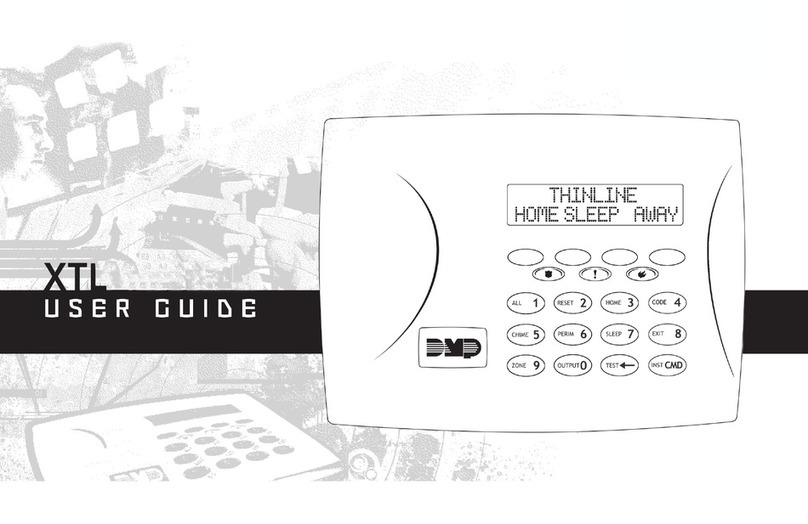
Digital Monitoring Products
Digital Monitoring Products XTL Series user guide
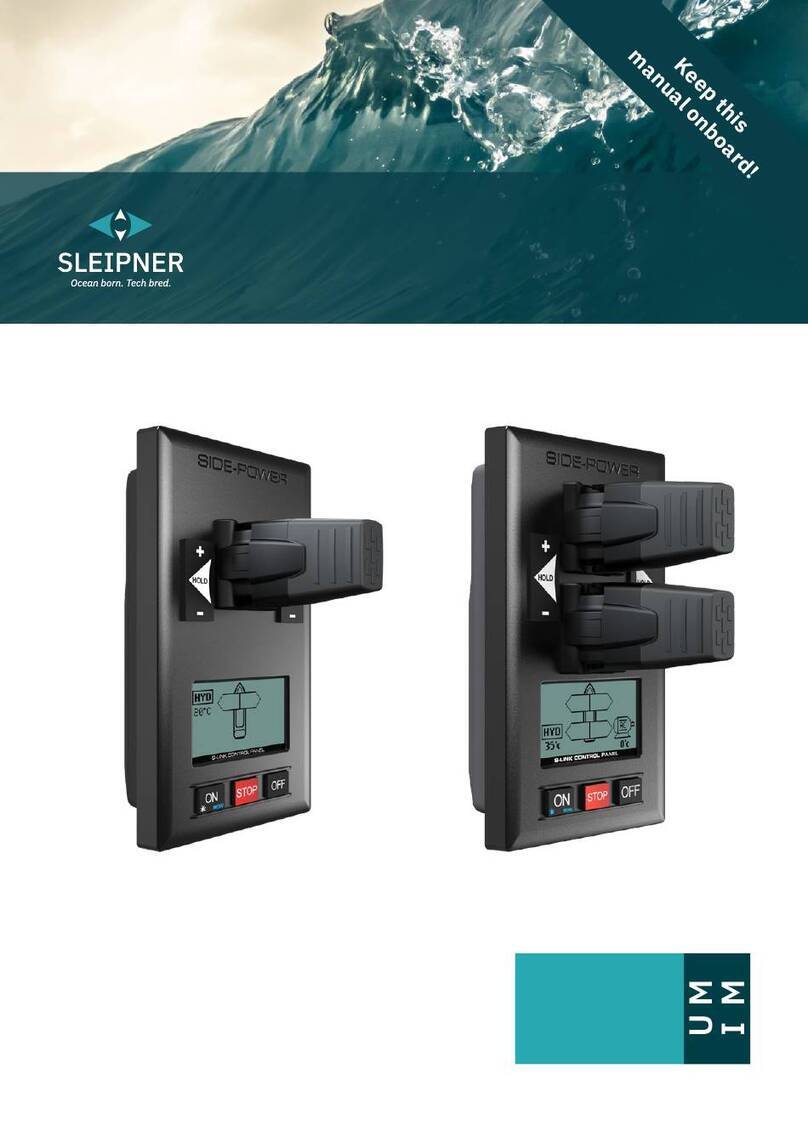
Sleipner
Sleipner PJC221 user manual

Zeta
Zeta INFINITY 8 installation manual
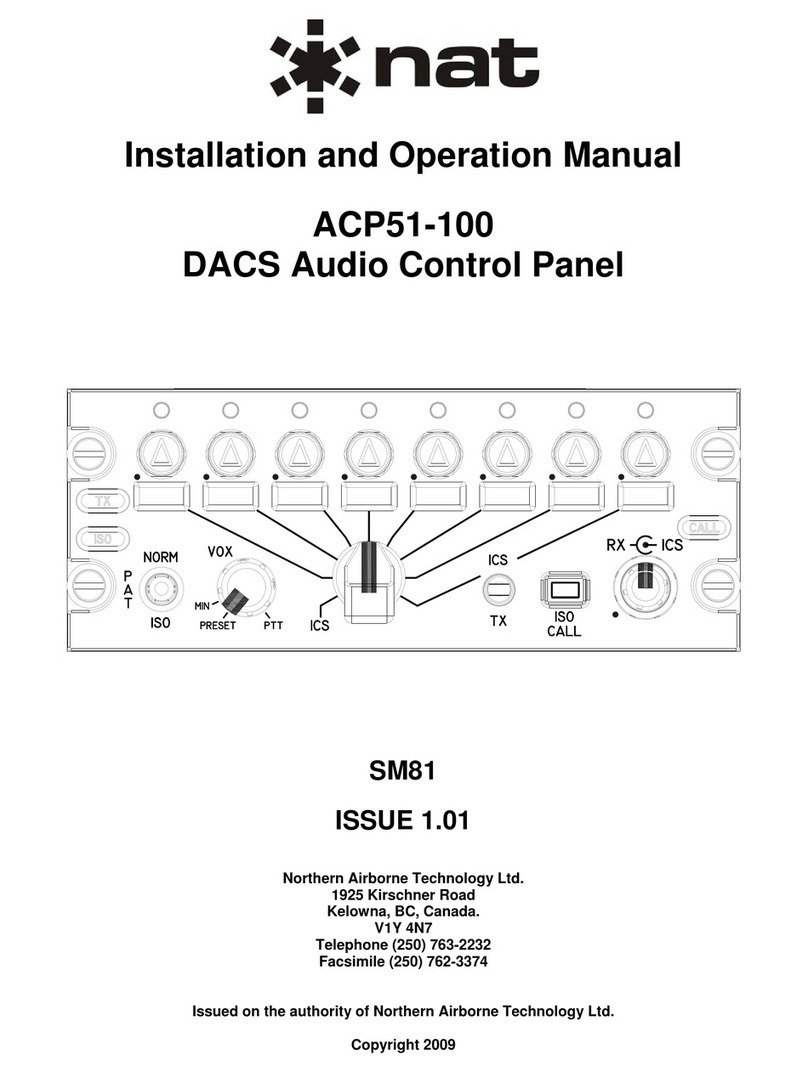
Nat
Nat ACP51-100 Installation and operation manual
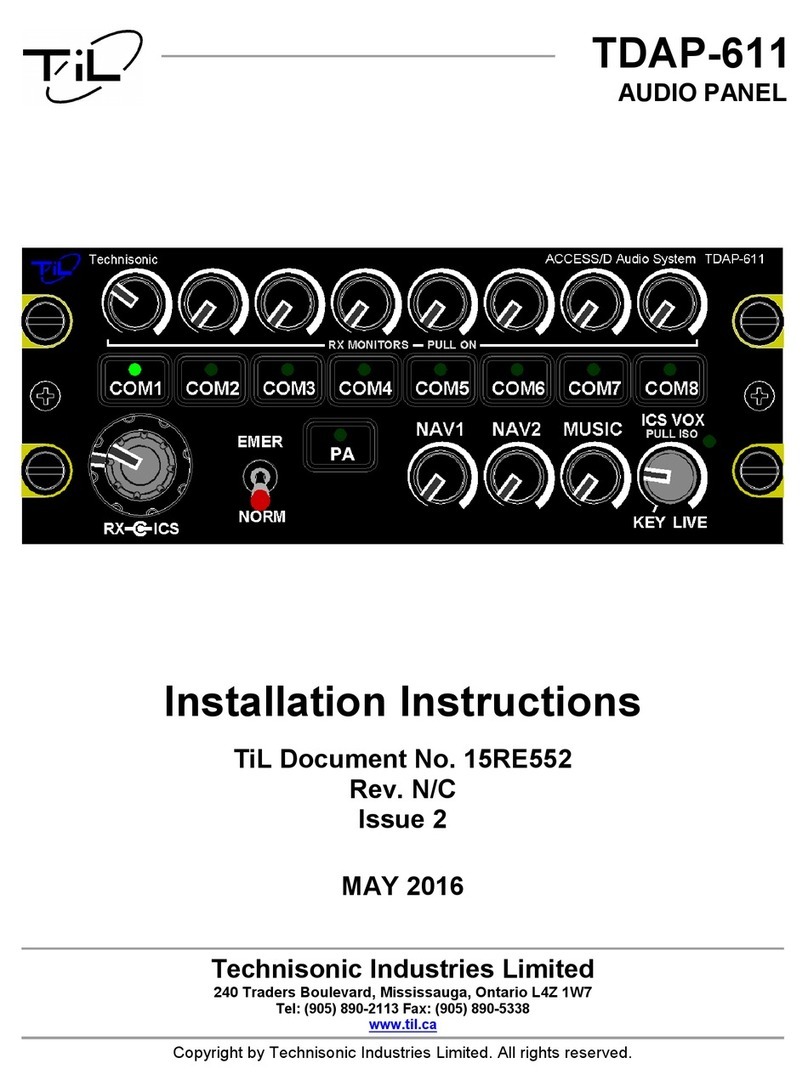
Technisonic Industries Limited
Technisonic Industries Limited TDAP-611 installation instructions

Panasonic
Panasonic AW-RP50 manual
